Totally tubeless, tubeless, and tubed percutaneous nephrolithotomy for treating kidney stones
- PMID: 37503906
- PMCID: PMC10375945
- DOI: 10.1002/14651858.CD012607.pub2
Totally tubeless, tubeless, and tubed percutaneous nephrolithotomy for treating kidney stones
Abstract
Background: Percutaneous nephrolithotomy (PNL) is the standard of care for removing large kidney stones (> 2 cm). Once the procedure is complete, different exiting strategies exist to manage the percutaneous tract opening, including placement of an external nephrostomy tube, placement of an internal ureteral stent, or no external or internal tube. The decision to place or not place a tube is handled differently among clinicians and may affect patient outcomes.
Objectives: To assess the effects of tubeless PNL (with ureteral stenting), totally tubeless PNL (without ureteral stenting or nephrostomy), and standard PNL (nephrostomy only) for the treatment of kidney stones in adults.
Search methods: We performed a systematic literature search in multiple biomedical databases (CENTRAL, MEDLINE, Embase, Web of Science), as well as in two clinical trial registries. We also handsearched reference lists of relevant publications and conference proceedings. We applied no language restrictions. The latest search update was conducted in September 2022.
Selection criteria: We included randomized controlled and quasi-randomized controlled trials of adult patients who received tubeless, totally tubeless, or standard PNL for treating kidney stones. We defined tubeless PNL as no nephrostomy tube, but ureteral stenting, while totally tubeless PNL meant no nephrostomy tube or ureteral stenting. Both interventions were compared to standard PNL with placement of a nephrostomy tube (only). We considered access tubes of any sizes. We only considered unilateral PNL with single-tract access. There were no exclusions on stone composition, size, or location.
Data collection and analysis: Two review authors independently screened the literature, extracted data, assessed risk of bias, and rated the certainty of evidence using GRADE. Primary outcomes were severe adverse events and postoperative pain, and secondary outcomes were operating time, length of hospital stay, and stone-free rate. We used the random-effects model for meta-analysis.
Main results: We included 10 studies in the review. Participant age varied among studies, ranging from 20 to 60 years. Detailed information on stone characteristics was rarely presented. Tubeless PNL versus standard PNL We are very uncertain whether there is a difference in severe adverse events (SAEs) between tubeless PNL and standard PNL (risk ratio (RR) 1.53, 95% confidence interval (CI) 0.14 to 16.46; I2 = 42%; 2 studies, 46 participants; very low-certainty evidence). Tubeless PNL may have little to no effect on pain on postoperative day one (mean difference (MD) 0.56 lower, 95% CI 1.34 lower to 0.21 higher; I2 = 84%; 4 studies, 186 participants; low-certainty evidence), and probably results in little to no difference in operating room time (MD 0.40 longer (in minutes), 95% CI 4.82 shorter to 5.62 longer; I2 = 0%; 3 studies, 81 participants; moderate-certainty evidence). Tubeless PNL may reduce length of hospital stay (MD 0.90 shorter, 95% CI 1.45 shorter to 0.35 shorter; I2 = 84%; 6 studies, 238 participants; low-certainty evidence). We are very uncertain of the effect of tubeless PNL on blood transfusions (RR 0.64, 95% CI 0.16 to 2.52; I2 = 0%; 4 studies, 161 participants; very low-certainty evidence), sepsis or fever (RR 0.50, 95% CI 0.05 to 4.75; I2 = not applicable; 2 studies, 82 participants; very low-certainty evidence), or readmissions (RR 1.00, 95% CI 0.07 to 14.21; I2 = not applicable, 1 study, 24 participants; very low-certainty evidence). Totally tubeless versus standard PNL Totally tubeless PNL may result in lower SAE rates (RR 0.49, 95% CI 0.19 to 1.25; I2 = 0%; 2 studies, 174 participants; low-certainty evidence) and pain on postoperative day one (MD 3.60 lower, 95% CI 4.24 lower to 2.96 lower; I2 = Not applicable; 1 study, 50 participants; low-certainty evidence). Totally tubeless PNL may result in little to no difference in operating room time (MD 6.23 shorter (in minutes), 95% CI 14.29 shorter to 1.84 longer; I2 = 72%; 2 studies, 174 participants; moderate-certainty evidence) and sepsis or fever (RR 0.33, 95% CI 0.01 to 7.97; I2 = not applicable; 1 study, 90 participants; low-certainty evidence). Totally tubeless PNL likely shortens the length of hospital stay (MD 1.55 shorter, 95% CI 1.82 shorter to 1.29 shorter; I2 = 0%; 4 studies, 274 participants; moderate-certainty evidence). We are very uncertain of the effect of totally tubeless PNL on blood transfusions (RR 0.62, 95% CI 0.26 to 1.48; I2 = 0%; 4 studies, 274 participants; very low-certainty evidence) or readmissions (RR not estimable, 95% CI not estimable; I2 = not applicable; 1 study, 50 participants; very low-certainty evidence). We found no studies comparing tubeless mini versus standard mini-PNL or totally tubeless mini versus standard mini-PNL.
Authors' conclusions: When comparing tubeless to standard PNL with regard to the predefined primary outcomes of this review, there may be little difference in early postoperative pain, while we are very uncertain of the effect on SAEs. People treated with tubeless PNL may benefit from a reduced length of stay compared to standard PNL. When comparing totally tubeless to standard PNL, early postoperative pain and severe adverse events may be reduced with totally tubeless PNL. The certainty of evidence by outcome was mostly very low (range: moderate to very low) for the comparison of tubeless to standard PNL and low (range: moderate to very low) for the comparison of totally tubeless to standard PNL. The most common reasons for downgrading the certainty of the evidence were study limitations, inconsistency, and imprecision. We did not find randomized trial evidence for other comparisons. Overall, further and higher-quality studies are needed to inform clinical practice.
Copyright © 2023 The Cochrane Collaboration. Published by John Wiley & Sons, Ltd.
Conflict of interest statement
KW: none known.
SH: none known.
FK: is a Contact Editor for Cochrane Urology; however, he was not involved in the editorial process of this review.
MS:
Schoelly GmbH, Denzlingen, Germany: Consultant (not related to tubeless PNL)
LUT GmbH, Denzlingen, Germany: performing workshops for 'Ultra‐mini PNL' (not related to tubeless PNL)
Neotract Inc., Pleasanton, CA, USA: performing workshops (for 'Urolift' for the treatment of lower urinary tract symptoms)
Two pending patents:
gel‐forming system for removing urinary calculi and fragments thereof;
kit for producing a cross‐linked gel to surround urinary calculi and/or fragments thereof.
The patents have been submitted and will be owned by the collaborating institutions (University Medical Center Freiburg and Fraunhofer Institute Munich) on 22 August 2013. MS is participating as an inventor.
The patents are pending (patents have been accepted by the European Patent Office, but a period for objection is still in progress).
The patents are not related to a competing intervention; they do not relate to whether tubes are used or not.
SS: none known.
Figures
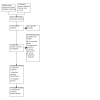
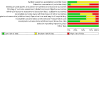


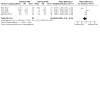

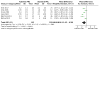

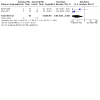





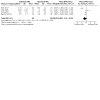


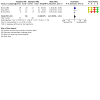
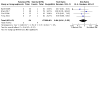


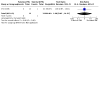









Update of
- doi: 10.1002/14651858.CD012607
References
References to studies included in this review
Basiri 2006 {published data only}
-
- Basiri A, Ahmadnia H, Moghaddam SM. The efficacy of conventional PCNL and two modifications to standard procedure. JPMA. The Journal of the Pakistan Medical Association 2006;56(7):302-5. - PubMed
Bhat 2017 {published data only}
Choi 2006 {published data only}
Crook 2008 {published data only}
Desai 2004 {published data only}
-
- Desai MR, Kukreja RA, Desai MM, Mhaskar SS, Wani KA, Patel SH, et al. A prospective randomized comparison of type of nephrostomy drainage following percutaneous nephrostolithotomy: Large bore versus small bore versus tubeless. Journal of Urology 2004;172(2):565-567. [DOI: ] - PubMed
Feng 2001 {published data only}
-
- Feng MI, Tamaddon K, Mikhail A, Kaptein JS, Bellman, GC. Prospective randomized study of various techniques of percutaneous nephrolithotomy. Urology 2001;58(3):345-50. - PubMed
Istanbulluoglu 2009 {published data only}
Marchant 2011 {published data only}
Mishra 2010 {published data only}
-
- Mishra S, Sabnis RB, Kurien A, Ganpule A, Muthu V, Desai, M. Questioning the wisdom of tubeless percutaneous nephrolithotomy (PCNL): a prospective randomized controlled study of early tube removal vs tubeless PCNL. BJU International 2010;106(7):1045-8; discussion 1048-9. [DOI: 10.1111/j.1464-410X.2010.09223.x] - DOI - PubMed
Moosanejad 2016 {published data only}
-
- Moosanejad N, Firouzian A, Hashemi SA, Bahari M, Fazli M. Comparison of totally tubeless percutaneous nephrolithotomy and standard percutaneous nephrolithotomy for kidney stones: a randomized, clinical trial. Brazilian Journal of Medical and Biological Research = Revista Brasileira de Pesquisas Medicas e Biologicas 2016;49(4):e4878. [DOI: 10.1590/1414-431X20154878] - DOI - PMC - PubMed
References to studies excluded from this review
Abdelhafez 2012 {published data only}
-
- Abdelhafez MF, Stenzl A, Schilling D. The minimally invasive PCNL (MIP): Comparison study between the management of small and large sized renal stones. European Urology Supplements 2012;11(1):E1031-U156.
Abdel Mohsen 2013 {published data only}
Abolella 2007 {published data only}
-
- Abolella H, Abdalla M, Shalaby M Jr, Hagaggy A. A lower calyceal single puncture percutaneous nephrolithotomy in management of complex renal stones. European Urology Supplements 2007;6(2):244-244. [DOI: 10.1016/s1569-9056(07)60880-x] - DOI
Agarwal 2011 {published data only}
Agarwal 2015 {published data only}
-
- Agarwal K, Agrawal MS, Mistry M, Shah S, Nelapatla R. Mini-PCNL with high power laser. European Surgical Research. Europaische Chirurgische Forschung. Recherches Chirurgicales Europeennes 2015;55:74.
Aghamir 2006 {published data only}
Aghamir 2011 {published data only}
-
- Aghamir SM, Modaresi SS, Aloosh M, Tajik A. Totally tubeless percutaneous nephrolithotomy for upper pole renal stone using subcostal access. Journal of Endourology 2011;25(4):583-6. - PubMed
Agrawal 2008 {published data only}
-
- Agrawal MS, Agrawal M, Gupta A, Bansal S, Yadav A, Goyal J. A randomized comparison of tubeless and standard percutaneous nephrolithotomy. Journal of Endourology 2008;22(3):439-42. - PubMed
Agrawal 2012 {published data only}
-
- Agrawal MS. Tubeless PCNL. International Journal of Urology 2012;19:240.
Agrawal 2014 {published data only}
Agrawal 2016 {published data only}
-
- Agrawal MS, Mishra D. Minimally-invasive percutaneous nephrolithotomy versus retrograde intrarenal surgery for treatment of medium sized (10-20 mm) renal calculi-a prospective study. Journal of Endourology 2016;30:A204-A205. [DOI: ]
Agrawal 2017 {published data only}
-
- Agrawal MS, Mishra D. Minimally-invasive percutaneous nephrolithotomy versus retrograde intrarenal surgery for treatment of medium sized (10-20 mm) renal calculi-a prospective study. Journal of Endourology. Conference: 34th World Congress of Endourology, WCE 2016. South Africa. Conference start: 20161108. Conference end: 20161112 2017;30:A204-A205. [DOI: 10.1089/end.2016.29020.abstracts] - DOI
Alam 2009 {published data only}
-
- Alam K, Biyabani R, Ather MH. The impact of nephrostomy tube size on post operative pain and perinephric collection after percutaneous nephrolithotomy. A randomized controlled trial. European Urology, Supplements. Conference: 24th Annual Congress of the European Association of Urology, EAU Stockholm Sweden. Conference Start: 20090317 Conference End: 20090321. Conference Publication: (var.pagings) 2009;8(4):264.
Albala 2001 {published data only}
-
- Albala DM, Assimos DG, Clayman RV, Denstedt JD, Grasso M, Gutierrez-Aceves J, et al. Lower pole I: A prospective randomized trial of extracorporeal shock wave lithotripsy and percutaneous nephrostolithotomy for lower pole nephrolithiasis—initial results. Journal of Urology 2001;166(6):2072-2080. [DOI: 10.1016/s0022-5347(05)65508-5] - DOI - PubMed
Al Bareeq 2008 {published data only}
Ali 2019 {published data only}
-
- Ali MI, Saha PK, Shafiqul Alam M, Chowdhury SA, Kamal N, Rahman M, et al. Outcomes of percutaneous nephrolithotomy with or without nephrostomy tube: A comparative study. Journal of Biosciences and Medicines 2019;7(3):52-60.
Al Kandari 2006 {published data only}
-
- Al-Kandari AM, Elshebiny YH, Shaaban H, Al-Enezi HK, Ibrahim HM. Single middle caliceal access during percutaneous nephrolithotomy for partial staghorn renal stones: An excellent approach. Journal of Endourology 2006;20:A134.
Alken 1982 {published data only}
-
- Alken P, Hutschenreiter G, Gunther R. Percutaneous kidney stone removal. European Urology 1982;8(5):304-311. - PubMed
Al Kohlany 2005 {published data only}
AlvarezVillarraga 2016 {published data only}
-
- Alvarez Villarraga JD, Carreno Galeano GL, Hernandez Garcia CE, Silva Herrera JM, Patino Sandoval GA. Conventional vs. tubeless percutaneous nephrolithotomy. Is the urinary diversion really necessary? Urologia Colombiana 2016;25(1):5-9. [DOI: ]
Anonymous 2004 {published data only}
-
- Upper pole versus lower pole percutaneous access for percutaneous nephrostolithotomy (PCNL) in patients with multiple renal calculi. Journal of Endourology 2004;18:151-A151.
Anonymous 2004b {published data only}
-
- Treatment of partial and full staghorn renal stones with PCNL utilizing a single puncture: The role of the flexible nephroscope. Journal of Endourology 2004;19:A71-A71.
Anonymous 2004c {published data only}
-
- PCNL monotherapy for Staghorn renal calculi at district place. Journal of Endourology 2004;18:A182-A182.
Anonymous 2005 {published data only}
-
- Treatment of upper urinary calculi by traditional and modified percutaneous nephrolithotomy—a single center experience of 20 years. Journal of Endourology 2005;19:A200-A200.
Anonymous 2005b {published data only}
-
- Renal stones treatment by percutaneous nephrolithotomy (PCNL). Journal of Endourology 2005;19:A73-A73.
Anonymous 2005c {published data only}
-
- PCNL techniques for treatment of upper urinary stone (18 years clinical report). Journal of Endourology 2005;19:A73-A73.
Anonymous 2005d {published data only}
-
- Minimal invasive PCNL in patients with renal pelvic and calyceal stones—enhanced experience in 119 cases. Journal of Endourology 2005;19:A73-A73.
Anonymous 2006 {published data only}
-
- Percutaneous treatment of large upper tract stones after urinary diversion. European Urology Supplements 2006;5(2):149-149. - PubMed
Anonymous 2006b {published data only}
-
- Minimal invasive PCNL in patients with renal pelvic and calyceal stones—enhanced experience in 164 patients. European Urology Supplements 2006;5(2):148-148.
Anonymous 2017 {published data only}
-
- Conventional vs. tubeless percutaneous nephrolithotomy. Is the urinary diversion really necessary? Urologia Colombiana 2017;25(1):5-9.
Antonelli 2009 {published data only}
-
- Antonelli J, Ferrandino MN, Zilberman DE, Pierre SA, Albala DM, Preminger GM. Tubeless-stentless percutaneous nephrolithotomy: A further advance in percutaneous urinary stone management. Journal of Urology 2009;181(4):624-624.
Arrabal Martin 2012 {published data only}
-
- Arrabal-Martin M, Arrabal-Polo MA, Lopez-Leon V, Merino-Salas S, Palao-Yago F, Camara-Ortega M, et al. The oblique supine decubitus position: technical description and comparison of results with the prone decubitus and dorsal supine decubitus positions. Urological Research 2012;40(5):587-592. [DOI: 10.1007/s00240-012-0471-5] - DOI - PubMed
Baptistussi 2009 {published data only}
-
- Baptistussi M, Morihisa M, Gewher E, Martins A. Renal stones treatment by percutaneous nephrolithotomy (PCNL). Journal of Endourology 2009;23:A273-A273.
Bellman 1997 {published data only}
Bhandarkar 2017 {published data only}
-
- Bhandarkar A. "Does size of sheath matter?" For minimally invasive percutaneous nephrolithotomy: Our prospective and randomized trial for small size (10-20 MM) renal calculi. Journal of Urology 2017;197(4):E438-E438.
Brightbill 2006 {published data only}
-
- Brightbill KE, Mehrazin R, Mancini J, Ogles M, Linn D, Derweesh IH, et al. Efficacy of tubeless percutaneous nephrostolithotomy for complex renal calculi. Journal of Endourology 2006;20:A110-A110.
Bryniarski 2018 {published data only}
Chang 2011 {published data only}
Chen 2011 {published data only}
-
- Chen L, Li JX, Yang B, Hu WG, Huang XB, Wang XF. Impacts of different nephrostomy tubes and their fixation ways on patients with nephrolithiasis complicated with renal insufficiency after percutaneous nephrolithotomy. Beijing Da Xue Xue Bao. Yi xue ban = Journal of Peking University. Health sciences 2011;43(6):878-881. - PubMed
Cheng 2010 {published data only}
-
- Cheng F, Yu W, Zhang X, Yang S, Xia Y, Ruan Y. Minimally invasive tract in percutaneous nephrolithotomy for renal stones. Journal of Endourology 2010;24(10):1579-1582. [DOI: ] - PubMed
Chung 2016 {published data only}
-
- Chung HS, Jung SL, Yu HS, Hwang EC, Oh KJ, Kwon DD, Park K. Modified totally tubeless percutaneous nephrolithotomy: Is it an effective and safe treatment option for renal and upper ureteral stones? Videosurgery and Other Miniinvasive Techniques 2016;11(4):240-246. [DOI: 10.5114/wiitm.2016.64447] - DOI - PMC - PubMed
Cormio 2012 {published data only}
-
- Cormio L, Perrone A, Di Fino G, Ruocco N, De Siati M, la Rosette J, et al. TachoSil (R) sealed tubeless percutaneous nephrolithotomy to reduce urine leakage and bleeding: outcome of a randomized controlled study. Journal of Urology 2012;188(1):145-150. [DOI: 10.1016/j.juro.2012.03.011] - DOI - PubMed
El Nahas 2012 {published data only}
-
- El-Nahas AR, Shokeir AA. Percutaneous nephrolithotomy: Keeping the bridge for one night. Urological Research 2012;40(4):389-393. [DOI: ] - PubMed
Ganesamoni 2013 {published data only}
-
- Ganesamoni R, Sabnis R, Mishra S, Ganpule A, Vyas J, Jagtap J, et al. Randomized controlled trial comparing totally tubeless, tubeless and early tube removal in miniperc. Journal of Endourology 2013;27:A331. [DOI: ] - PubMed
Gonen 2019 {published data only}
-
- Gönen M, Arslan ÖE, Dönmez Mİ, Halat AÖ, Sezgin T. Ureteral catheter versus nephrostomy tube for patients undergoing percutaneous nephrolithotomy under spinal anesthesia: a prospectively randomized trial. Journal of Endourology 2019;33(4):291-294. - PubMed
Gonzalez 2012 {published data only}
-
- Gonzalez LC, Ramirez AG, Aceves JG. Comparative outcomes of PCNL in the treatment of staghorn stones and large non-staghorn renal stones. Journal of Endourology 2012;26:A369-A370.
Gupta 2005 {published data only}
Hai 2012 {published data only}
-
- Hai L, Kong X, Gu X, Zhang M. The comparation of totally tubeless percutaneous nephrolithotomy and conventional percutaneous nephrolithotomy: A prospective randomized controlled study. International Journal of Urology 2012;19:175. [DOI: ]
Hammes 2009 {published data only}
-
- Hammes C, Wezel F, Haecker A, Michel M, Bach T. PCNL vs. Mini-PCNL for renal stones < 4cm. Journal of Endourology 2009;23:A212-A213.
He 2015 {published data only}
Hong 2016 {published data only}
-
- Hong M, Paul E, Berman I, Shahbaz S, McCahy P. The optimal treatment for 1-2 cm renal stones: randomised trial of percutaneous nephrolithotomy versus ureterorenoscopy versus shockwave lithotripsy. BJU International 2016;117:57-58.
ISRCTN67807054 {published data only}
-
- ISRCTN67807054. Prospective randomised trial of tubeless vs conventional percutaneous nephrolithotomy (PCNL). trialsearch.who.int/Trial2.aspx?TrialID=ISRCTN67807054 (first received 30 September 2005).
Istanbulluoglu 2010 {published data only}
-
- Istanbulluoglu MO, Cicek T, Ozturk B, Gonen M, Ozkardes H. Percutaneous nephrolithotomy: nephrostomy or tubeless or totally tubeless? Urology 2010;75(5):1043-1046. [DOI: ] - PubMed
Istanbulluoglu 2013 {published data only}
-
- Istanbulluoglu MO, Kaynar M, Cicek T, Kosan M, Ozturk B, Ozkardes H. A new hemostatic agent (Ankaferd Blood Stopper) in tubeless percutaneous nephrolithotomy: A prospective randomized study. Journal of Endourology 2013;27(9):1126-1130. [DOI: ] - PubMed
Jun Ou 2010 {published data only}
-
- Jun-Ou J, Lojanapiwat B. Supracostal access: Does it affect tubeless percutaneous nephrolithotomy efficacy and safety? International Braz J Urol 2010;36(2):171-176. [DOI: ] - PubMed
Kara 2010 {published data only}
-
- Kara C, Resorlu B, Bayindir M, Unsal A. A randomized comparison of totally tubeless and standard percutaneous nephrolithotomy in elderly patients. Urology 2010;76(2):289-293. [DOI: ] - PubMed
Karadeniz 2010 {published data only}
-
- Karadeniz T, Baran C, Topsakal M, Ozkaptan O. A safe technique for control of bleeding after percutaneous nephrolithotomy. Current Urology 2010;4(1):33-6. [DOI: 10.1159/000253406] - DOI
Karami 2004 {published data only}
Kumar 2016 {published data only}
Kumar 2017 {published data only}
-
- Kumar A, Singh SK, Pawar DS, Yadav L, Mittal S. To evaluate the applications of totally tubeless mini percutaneous nephrolithotomy (PCNL) and compare it with standard mini PCNL. Indian Journal of Urology 2017;33:(no pagination).
Lee 2015 {published data only}
-
- Lee JW, Park J, Lee SB, Son H, Cho SY, Jeong H. Mini-percutaneous nephrolithotomy vs retrograde intrarenal surgery for renal stones larger lhan 10 mm: A prospective randomized controlled trial. Urology 2015;86(5):873-877. - PubMed
Li 2011 {published data only}
-
- Li R, Louie MK, Lee HJ, Osann K, Pick DL, Santos RS, et al. Prospective randomized trial of three different methods of nephrostomy tract closure after percutaneous nephrolithotripsy. BJUI 2011;107:1660-1665. - PubMed
Liatsikos 2002 {published data only}
-
- Liatsikos EN, Hom D, Dinlenc CZ, Kapoor R, Alexianu M, Yohannes P, et al. Tail stent versus re-entry tube: A randomized comparison after percutaneous stone extraction. Urology 2002;59(1):15-19. [DOI: ] - PubMed
Lu 2012 {published data only}
-
- Lu Y, Ping J, Zhao X, Hu L, Pu J. Randomized prospective trial of tubeless versus conventional minimally invasive percutaneous nephrolithotomy. World Journal of Urology 2013;31:1303-1307. - PubMed
Ma 2013 {published data only}
-
- Ma N, Chen H, Luo Y, Long X, Zeng F, Wang J, et al. Foley catheter traction for hemorrhage after post microchannel percutaneous nephrolithotomy. Journal of Central South University (Medical Sciences) 2013;38(1):86-89. [DOI: ] - PubMed
Mandhani 2007 {published data only}
Marcovich 2004 {published data only}
Mercado 2013 {published data only}
-
- Mercado A, Fernández MI, Recabal P, Fleck D, Ledezma R, Moya F, et al. Immediate postoperative morbidity in patients with indwelling double-J stent versus overnight-externalized ureteral catheter after tubeless percutaneous nephrolithotomy: a prospective, randomized study. Urolithiasis 2013;41(3):253-6. [DOI: 10.1007/s00240-013-0555-x] - DOI - PubMed
Millard 2009 {published data only}
-
- Millard WW, Jellison FC, Tenggardjaja CF, Nicolay LI, Baldwin DD. The hemostatic sandwich: A tamponade method for controlling severe bleeding in percutaneous kidney stone surgery. Journal of Investigative Medicine 2009;57(1):148-148.
Monga 2008 {published data only}
-
- Monga M. Percutaneous nephrolithotomy: leave a tube! Journal of Endourology 2008;22(9):1863-4; discussion 1871. [DOI: ] - PubMed
Moosanejad 2016a {published data only}
-
- Moosanejad N, Firouzian A, Hashemi SA, Bahari M, Fazli M. Comparison of totally tubeless percutaneous nephrolithotomy and standard percutaneous nephrolithotomy for kidney stones: A randomized, clinical trial. Brazilian Journal of Medical and Biological Research 2016;49(4):e4878. [DOI: ] - PMC - PubMed
NCT01437904 {published data only}
-
- NCT01437904. A pilot study assessing the feasibility of outpatient tubeless percutaneous nephrolithotomy (PCNL). clinicaltrials.gov/ct2/show/NCT01437904 (first received 21 September 2011).
NCT02036398 {published data only}
-
- NCT02036398. Tubeless versus standard upper pole percutaneous nephrolithotomy. clinicaltrials.gov/ct2/show/NCT02036398 2014.
NCT03907930 {published data only}
-
- NCT03907930. Comparative study between tubeless and standard percutaneous nephrolithotomy. Randomized. clinicaltrials.gov/ct2/show/NCT03907930 2019.
Nirmal 2009 {published data only}
-
- Nirmal TJ, Samiran A. Totally tubeless percutaneous nephrolithotomy: Is it safe. Indian Journal of Urology 2009;25(3):418-419.
Okeke 2009 {published data only}
-
- Okeke Z, Andonian S, Srinivasan A, Shapiro E, Vanderbrink BA, Kavoussi LR, et al. Cryotherapy of the nephrostomy tract: a novel technique to decrease the risk of hemorrhage after tubeless percutaneous renal surgery. Journal of Endourology 2009;23(3):417-20. [DOI: ] - PubMed
Ozturk 2015 {published data only}
Pietrow 2003 {published data only}
Portis 2004 {published data only}
-
- Portis AJ, Laliberte MA, Drake S, Scheltema K, Rosenberg MS, Bretzke CA. Tubeless percutaneous nephrolithotomy: Efficacy and safety for large volume nephrolithiasis. Journal of Urology 2004;171(4):501-502.
Sabnis 2014 {published data only}
-
- Sabnis R, Ganpule A, Mishra S, Vyas J, Ganeshmoni R, Jagtap J, et al. Exit strategy following MPNL—prospective randomized study. Journal of Urology 2014;191(4 suppl. 1):e187. [DOI: 10.1016/j.juro.2014.02.699] - DOI
Sebaey 2016 {published data only}
Shah 2006 {published data only}
-
- Shah HN, Hegde S, Shah JN, Mohile PD, Yuvaraja TB, Bansal MB. A prospective, randomized trial evaluating the safety and efficacy of fibrin sealant in tubeless percutaneous nephrolithotomy. Journal of Urology 2006;176(6):2488-2493. [DOI: ] - PubMed
Shoma 2012 {published data only}
Singh 2008 {published data only}
-
- Singh I, Singh A, Mittal G. Tubeless percutaneous nephrolithotomy: is it really less morbid? Journal of Endourology 2008;22(3):427-34. [DOI: ] - PubMed
Singh 2013 {published data only}
-
- Singh BP, Sankhwar SN. Tubeless percutaneous nephrolithotomy for complex renal calculi and complicated procedures. Journal of Urology 2013;189(4):E631-E631.
Su 2015 {published data only}
-
- Su H, Zhu Y, Deng Q, Pei L, Wang J. Application of nephrostomy tubes with balloon after percutaneous nephrolithotomy: A randomized controlled clinical trial. International Journal of Urology 2015;22(12):1118-1121. [DOI: ] - PubMed
Taghavi 2011 {published data only}
-
- Taghavi R, Reza M, Mahboub D. Comparison of the results and complications between standard and tubeless percoutaneous nephrolithotomy. Journal of Endourology / Endourological Society 2011;25:A6. [DOI: 10.1089/end.2011.2003.supp] - DOI
Tefekli 2007 {published data only}
Telha 2010 {published data only}
-
- Telha KA, Alba'adani TH, Alkohlany KM, Al-Adimy AO, Alnono IH. Tubeless percutaneous nephrolithotomy with double-J stent compared with external ureteral catheter to decrease postoperative complications. Saudi Medical Journal 2010;31(10):1137-40. - PubMed
Yoon 2008 {published data only}
-
- Yoon GH, Bellman GC. Tubeless percutaneous nephrolithotomy: a new standard in percutaneous renal surgery. Journal of Endourology 2008;22(9):1865-7; discussion 1869. [DOI: ] - PubMed
Yun 2012 {published data only}
Zhao 2016 {published data only}
-
- Zhao P, Gaunay GS, Hoenig DM, Smith AD, Okeke Z. A randomized controlled comparison of nephrostomy drainage versus ureteral stent following percutaneous nephrolithotomy using the Wisconsin StoneQOL. Journal of Endourology 2016;30:A378. [DOI: ] - PubMed
Zhao 2016a {published data only}
-
- Zhao PT, Hoenig DM, Smith AD, Okeke Z. A randomized controlled comparison of nephrostomy drainage vs ureteral stent following percutaneous nephrolithotomy using the Wisconsin stone QOL. Journal of Endourology 2016;30(12):1275-1284. [DOI: ] - PubMed
Zhou 2017 {published data only}
-
- Zhou Y, Zhu J, Gurioli A, Yuan D, Luo J, Li Z, et al. Randomized study of ureteral catheter vs double-J stent in tubeless minimally invasive percutaneous nephrolithotomy patients. Journal of Endourology 2017;31(3):278-282. [DOI: ] - PubMed
Ziaee 2013 {published data only}
-
- Ziaee SAM, Sarhangnejad R, Abolghasemi H, Eshghi P, Radfar MH, Ahanian A, et al. Autologous fibrin sealant in tubeless percutaneous nephrolithotomy; a prospective study. Urology Journal 2013;10(3):999-1003. - PubMed
References to studies awaiting assessment
Folin 2017 {published data only}
-
- Folin L, Xiaofeng Z, Rihai X, Yuanhu Y, Gengqing W, Xiaoning W, et al. A prospective randomized controlled study of instantly phase-II tubeless percutaneous nephrolithotomy. European Urology 2017;16(3):e968.
Gyawali 2017 {published data only}
-
- Gyawali P. Tubeless vs totally tubeless percutaneous lithotripsy—a randomised control trial. International Journal of Urology. Conference: 14th Asian Congress of Urology of the Urological Association of Asia, ACU 2016. Singapore. Conference start: 20160720. Conference end: 20160724. Conference publication: (var.pagings) 2017;23:92. [DOI: 10.1111/iju.13149] - DOI
IRCT201204169485N1 {published data only}
-
- IRCT201204169485N1. Comparison between kidney stone surgery through the skin, without nephrostomy tube method and without any tube method versus classic method. Clinical Trial Registry 2012. [https://trialsearch.who.int/Trial2.aspx?TrialID=IRCT201204169485N1]
IRCT201611019014N129 {published data only}
-
- IRCT201611019014N129. Comparison of the adverse effect of two methods of nephrolithotomy in patients having kidney stone. Clinical Trial Registry 2016. [https://trialsearch.who.int/Trial2.aspx?TrialID=IRCT201611019014N129]
Murali 2015 {published data only}
-
- Murali V. Exit strategy following Mini-PNL—prospective randomized study. In: Indian Journal of Urology. Vol. 31. 2015:S53-S54.
NCT01548196 {published data only}
-
- NCT01548196. Standard percutaneous nephrolithotomy percutaneous nephrolithotomy (PNL) versus tubeless PNL versus tubeless stentless PNL. Clinical Trial Registry 2011. [https://clinicaltrials.gov/ct2/show/NCT01548196]
Ramasamy 2019 {published data only}
-
- Ramasamy N, Balasubramanyan JK, Thirunavukarasu C, Kumerasan N, Reddy G. Efficacy and safety of standard versus tubeless percutaneous nephrolithotomy—a randomized controlled study. Journal of Evolution of Medical and Dental Sciences-Jemds 2019;8(25):2002-2006.
Taghavi 2013 {published data only}
-
- Taghavi R, Darabi MR, Jahed, Ataeian S. Comparison of the results and complications between standard and tubeless percoutaneous nephrolithotomy. European Urology, Supplements 2013;12(4):e1337. [DOI: 10.1016/S1569-9056%2813%2962262-9] - DOI
References to ongoing studies
CTRI/2018/07/015022 {published data only}
-
- CTRI/2018/07/015022. Comparison of two surgeries—standard and tubeless percutaneous nephrolithotomy for the treatment of kidney stones—a prospective randomized control study. clinical trial registry 2018. [https://trialsearch.who.int/Trial2.aspx?TrialID=CTRI/2018/07/015022]
NCT04069013 {unpublished data only}
-
- Randomized Controlled Trial Comparing Surgical Outcomes Following PCNL and Mini PCNL in the Treatment of Kidney Stones. [https://clinicaltrials.gov/ct2/show/NCT04069013]
Additional references
Amer 2012
-
- Amer T, Ahmed K, Bultitude M, Khan S, Kumar P, De Rosa A, et al. Standard versus tubeless percutaneous nephrolithotomy: a systematic review. Urology International 2012;Mar 88:373-82. - PubMed
ASA 2014
-
- American Society of Anesthesiologists. ASA Physical Status Classification System. www.asahq.org/resources/clinical-information/asa-physical-status-classif... accessed 20 March 2017.
Assimos 2016
-
- Assimos D, Krambeck A, Miller NL, Monga M, Murad MH, Nelson CP, et al. Surgical management of stones: American Urological Association/Endourological Society Guideline, Part I. J Urol 2016;196(4):1153-60. - PubMed
Chen 2020
-
- Chen ZJ, Yan YJ, Zhou JJ. Comparison of tubeless percutaneous nephrolithotomy and standard percutaneous nephrolithotomy for kidney stones: A meta-analysis of randomized trials. Asian J Surg 2020;43(1):60-68. - PubMed
de la Rosette 2012
-
- la Rosette JJ, Opondo D, Daels FP, Giusti G, Serrano A, Kandasami SV, et al, CROES PCNL Study Group. Categorisation of complications and validation of the Clavien score for percutaneous nephrolithotomy. European Urology 2012 Aug;62(2):246-55. - PubMed
Deeks 2011
-
- Deeks JJ, Higgins JPT, Altman DG (editors). Chapter 9: Analysing data and undertaking meta-analyses. In: Higgins JPT, Green S (editors). Cochrane Handbook for Systematic Reviews of Interventions. Version 5.1.0 (updated March 2011). The Cochrane Collaboration, 2011. Available from training.cochrane.org/handbook/archive/v5.1/.
Deng 2020
-
- Deng J, Li J, Wang L, et al. Standard versus mini-percutaneous nephrolithotomy for renal stones: a meta-analysis. Scand J Surg published online ahead of print;2020 Jun 3:doi:10.1177/1457496920920474. - PubMed
Garofalo 2013
-
- Garofalo M, Pultrone CV, Schiavina R, Brunocilla E, Sanguedolce F, Borghesi M, et al. Tubeless procedure reduces hospitalization and pain after percutaneous nephrolithotomy: results of a multivariable analysis. Urolithiasis 2013 Aug;41(4):347-53. - PubMed
Gonen 2009
-
- Gonen M, Ozturk B, Ozkardes H. Double-j stenting compared with one night externalized ureteral catheter placement in tubeless percutaneous nephrolithotomy. Journal of Endourology 2009 Jan;23(1):27–31. - PubMed
GRADEpro GDT [Computer program]
-
- GRADEpro GDT. Version accessed 20 March 2017. Hamilton (ON): McMaster University (developed by Evidence Prime). Available at gradepro.org.
Guyatt 2008
-
- Guyatt GH, Oxman AD, Vist GE, Kunz R, Falck-Ytter Y, Schünemann HJ, et al. GRADE: what is "quality of evidence" and why is it important to clinicians? BMJ (Clinical Research Ed.) 2008;336(7651):995-8. [DOI: 10.1136/bmj.39490.551019.BE] - DOI - PMC - PubMed
Guyatt 2011
Hesse 2003
-
- Hesse A, Brändle E, Wilbert D, Köhrmann KU, Alken P. Study on the prevalence and incidence of urolithiasis in Germany comparing the years 1979 vs. 2000. European Urology 2003;44:709-13. - PubMed
Higgins 2002
Higgins 2003
Higgins 2011a
-
- Higgins JPT, Green S (editors). Cochrane Handbook for Systematic Reviews of Interventions. Version 5.1.0 (updated March 2011). The Cochrane Collaboration, 2011. Available from training.cochrane.org/handbook/archive/v5.1/.
Higgins 2011b
-
- Higgins JPT, Altman DG, Sterne JAC (editors). Chapter 8: Assessing risk of bias in included studies. In: Higgins JPT, Green S (editors). Cochrane Handbook for Systematic Reviews of Interventions. Version 5.1.0 (updated March 2011). The Cochrane Collaboration, 2011. Available from training.cochrane.org/handbook/archive/v5.1/.
Higgins 2011c
-
- Higgins JPT, Deeks JJ, Altman DG (editors). Chapter 16: Special topics in statistics. In: Higgins JPT, Green S (editors). Cochrane Handbook for Systematic Reviews of Interventions. Version 5.1.0 (updated March 2011). The Cochrane Collaboration, 2011. Available from training.cochrane.org/handbook/archive/v5.1/.
Hüsch 2015
-
- Hüsch T, Reiter M, Mager R, Steiner E, Herrmann TR, Haferkamp A, et al. The management of the access tract after percutaneous nephrolithotomy. World Journal of Urology 2015 Dec;33(12):1921-8. - PubMed
Kamphuis 2015
-
- Kamphuis GM, Baard J, Westendarp M, la Rosette JJ. Lessons learned from the CROES percutaneous nephrolithotomy global study. World Journal of Urology 2015 Feb;33(2):223-33. - PubMed
Li 2020
-
- Li Q, Gao L, Li J, Zhang Y, Jiang Q. Total tubeless versus standard percutaneous nephrolithotomy: a meta-analysis. Minim Invasive Ther Allied Technol 2020;29(2):61-69. [PMID: ] - PubMed
Lieske 2006
-
- Lieske JC, Peña de la Vega LS, Slezak JM, Bergstralh EJ, Leibson CL, Ho KL, et al. Renal stone epidemiology in Rochester, Minnesota: an update. Kidney International 2006;69(4):760-4. - PubMed
Review Manager 2020 [Computer program]
-
- Review Manager 5 (RevMan 5). Version 5.4. Copenhagen: The Cochrane Collaboration, 2020.
Scales 2012
Schünemann 2011
-
- Schünemann HJ, Oxman AD, Higgins JPT, Vist GE, Glasziou P, Guyatt GH. Chapter 11: Presenting results and ‘Summary of findings' tables. In: Higgins JPT, Green S (editors), Cochrane Handbook for Systematic Reviews of Interventions. Version 5.1.0 [updated March 2011]. The Cochrane Collaboration, 2011. Available from training.cochrane.org/handbook/archive/v5.1/.
Sivalingam 2014
-
- Sivalingam S, Cannon ST, Nakada SY. Current practices in percutaneous nephrolithotomy among endourologists. Journal of Endocrinology 2014 May;28(5):524–7. - PubMed
Stamatelou 2003
-
- Stamatelou KK, Francis ME, Jones CA, Nyberg LM, Curhan GC. Time trends in reported prevalence of kidney stones in the United States: 1976-1994. Kidney International 2003 May;63(5):1817-23. - PubMed
Thompson 2020
-
- Thompson E, Lai A, Morrey L, Borofsky MS, Dahm P. A longitudinal assessment of the reporting quality of randomized controlled trials for surgical interventions to treat nephrolithiasis over 16 years (2002 to 2017). J Endourol 2020;34(4):502-508. - PubMed
Türk 2020
-
- Türk C, Neisius A, Petrik A, Seitz C, Skolarikos A, Thomas K. EAU Guidelines on urolithiasis 2020. https://uroweb.org/guidelines/urolithiasis 2020.
Wright 2016
References to other published versions of this review
Publication types
MeSH terms
LinkOut - more resources
Full Text Sources

